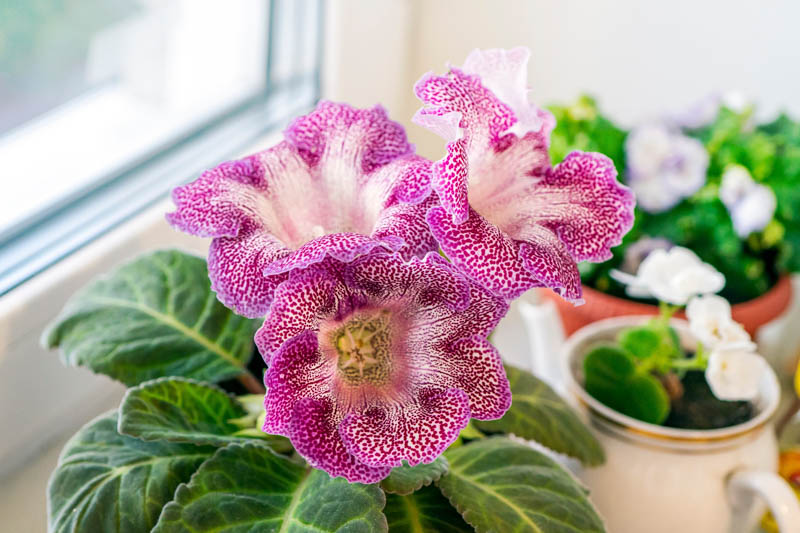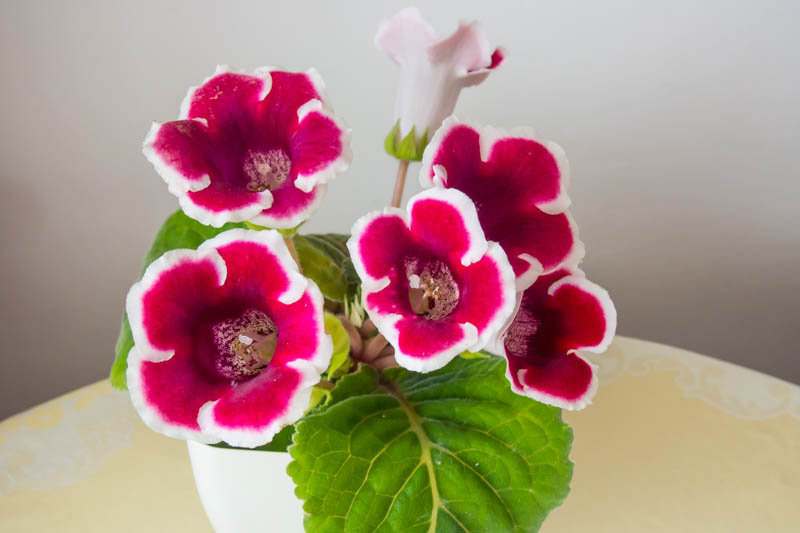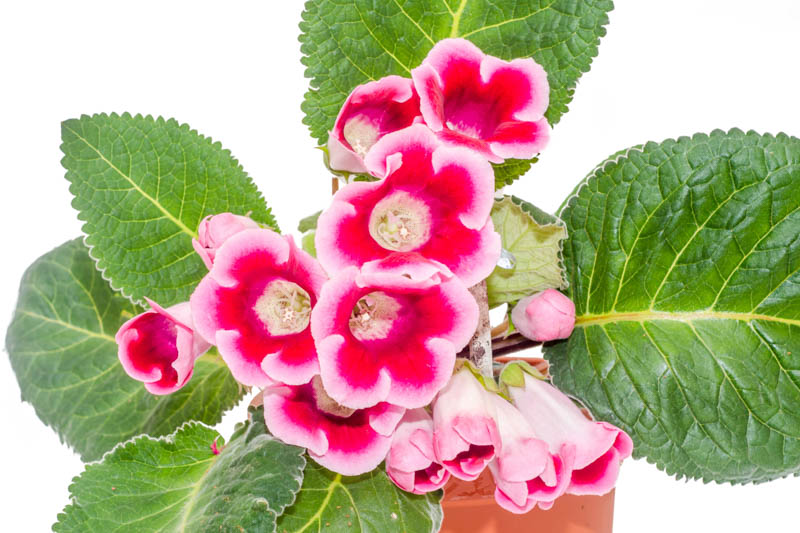Bright Eyes, Florist Gloxinia, Gloxina, Gloxinia, Violet Slipper Gloxinia
Sinningia speciosa, commonly known as Gloxinia or Florist’s Gloxinia, is a vibrant and popular houseplant celebrated for its lush foliage and stunning, bell-shaped flowers.
Gloxinia boasts large, velvety, oval-shaped leaves that grow in a rosette pattern. Its flowers are large and trumpet-shaped, available in a variety of colors including red, pink, white, purple, and sometimes with intricate patterning.
Native: This species is native to Brazil, where it thrives in the warm climates of tropical forests, often growing on rocky outcroppings. It belongs to the gesneriad family, Gesneriaceae, which includes Achimenes (Hot Water Plant), Streptocarpus (Cape Primrose), and the popular Sainpaulia (African Violet).
Plant Type and Habit: Gloxinia is a tuberous perennial with a compact, mounding habit.
Size: The plant generally reaches about 6-12 inches (15-30 cm) in height and can spread equally wide, depending on the size of the container and the growth conditions provided.
Flowers: Its flowers are its most striking feature, large and showy, up to 3 inches (7 cm) across. They appear singly or in clusters from the leaf axils and can last several weeks under ideal conditions. The bloom time usually spans late spring through summer, depending on when the plant was started indoors.
Foliage: The foliage is as attractive as its blooms, with soft, downy leaves that are deep green, sometimes with a reddish underside, adding to its ornamental value.
Hardiness: It is tender to frost and thrives best in USDA hardiness zones 11-12 if planted outdoors. In most temperate climates, it is cultivated as an indoor plant.
Uses: Primarily used as an ornamental plant, Gloxinia is popular in indoor settings for its decorative flowers and leaves. It is also used in breeding programs to create hybrids with varied colors and patterns.
Toxicity: Sinningia speciosa is non-toxic to pets and humans, making it a safe choice for a household indoor plant.
Invasiveness: Sinningia speciosa is not considered invasive. It is primarily grown as a contained houseplant and does not have the natural tendencies or capabilities to spread aggressively.
Benefits: Apart from its ornamental appeal, growing Sinningia speciosa can add a touch of vibrancy to any indoor space, helping to improve mood and aesthetic appeal. It also has a relatively easy care routine compared to other flowering houseplants.

Light: Gloxinia prefers bright, indirect light. Avoid direct sunlight, which can scorch its delicate leaves. A north or east-facing window is ideal, providing enough light without the harsh intensity of direct sun.
Soil: Use a well-draining, loose potting mix rich in organic matter. A mix designed for African violets works well for Gloxinias, as it provides the necessary drainage and aeration.
Watering: Keep the soil consistently moist but not soggy. Water the plant when the top inch of soil feels dry to the touch. Water from below to avoid getting water on the leaves, which can lead to fungal diseases.
Humidity: Gloxinia benefits from a humid environment. If your home is dry, especially during winter, use a humidity tray or a room humidifier to increase the moisture in the air around the plant.
Temperature: This plant thrives in warmer conditions, ideally between 65°F to 75°F (18°C to 24°C). Keep it away from drafts and sudden temperature changes, which can stress the plant and lead to leaf drop.
Fertilizing: During the growing season (spring to fall), feed your Gloxinia every two weeks with a balanced, water-soluble fertilizer diluted to half the recommended strength. Reduce feeding during the dormant period in winter when the plant is not actively growing.
Pruning: To encourage longer blooming, deadhead the spent flowers to promote new growth. After the blooming period and as the plant enters dormancy, prune back any dead or dying foliage. This helps prevent disease and prepares the plant for new growth in the next season.
Dormancy Care: Once the leaves begin to die back, gradually reduce watering, allowing the soil to dry out more between waterings. Move the plant to a cooler, darker area to rest. During this time, water sparingly, just enough to prevent the soil from completely drying out.
Repotting: Repot the plant every couple of years to refresh the soil and address any root-bound issues.

Propagating Gloxinia is a rewarding way to multiply your collection of these beautiful plants. Several effective methods for propagating Gloxinia include leaf cuttings, seed, and division.
Selecting a Leaf: Choose a healthy, mature leaf from the Gloxinia plant. Ensure it’s free from any signs of disease or damage.
Preparing the Leaf: Using a clean, sharp knife or scissors, cut the leaf petiole at an angle, leaving about an inch of the stem attached to the leaf blade.
Rooting the Leaf: Fill a small pot with a well-draining soil mix, such as one formulated for African violets or similar plants. Dip the cut end of the leaf petiole into rooting hormone powder to encourage root growth. Insert the petiole into the soil, ensuring the leaf blade is not buried but rests above the soil surface. Water gently to settle the soil around the leaf stem and cover the pot with a plastic bag or place it in a mini greenhouse to maintain high humidity.
Caring for the Cutting: Place the pot in bright, indirect light and maintain a temperature around 70°F (21°C). Keep the soil lightly moist but not waterlogged. Roots and new shoots should appear in 4-6 weeks. Once new growth is evident, gradually acclimatize the plant to less humid conditions by opening the cover progressively.
Sowing Seeds: Gloxinia seeds are extremely fine and should be sown on the surface of a pre-moistened, well-draining seed-starting mix. Do not cover the seeds with soil as they need light to germinate.
Germination Conditions: Cover the seed tray with clear plastic or glass to maintain humidity and place it in a warm, brightly lit area without direct sunlight. Seeds typically germinate in 2-3 weeks at temperatures between 70°F and 75°F (21°C to 24°C).
Seedling Care: Once seedlings emerge, gradually remove the cover to acclimate them to lower humidity. When seedlings are large enough to handle, transplant them into individual pots.
Dividing the Tuber: This method is best done in late winter or early spring when the plant is beginning to come out of dormancy. Gently remove the plant from its pot and clear the soil from around the tuber. Using a clean, sharp knife, divide the tuber, ensuring each section has at least one growth point.
Planting Tubers: Plant each tuber section in its own pot filled with a suitable potting mix. Water lightly and place in a warm, brightly lit area to encourage growth.
Each propagation method has its advantages, and the choice can depend on the resources available and personal preference. Leaf cuttings and division are typically quicker for producing a mature plant, while seeds can be a fun experiment but require more patience. With proper care, your new Gloxinia plants will start to thrive, eventually blooming with the same vibrant flowers as the parent plant.

Gloxinia is relatively easy to care for but, like all plants, can be susceptible to certain pests, diseases, and common cultural problems. Identifying these issues early and managing them effectively can help ensure your plant remains healthy and attractive. Here’s what to watch out for:
Mealybugs: These pests appear as small, white, cottony masses on the plant. Like aphids, they suck sap and weaken the plant, and also excrete honeydew.
Spider mites: These tiny arachnids are barely visible to the naked eye but can cause significant damage. They suck sap from the leaves, leading to stippled, discolored foliage and overall plant stress. Spider mites thrive in dry conditions.
Aphids: Small, soft-bodied insects that cluster on new growth and the undersides of leaves, aphids can weaken the plant by sucking sap and excreting sticky honeydew.
Fungus gnats: Small, dark flying insects that infest moist, rich soils, especially in houseplants. Their larvae feed on fungi and decaying organic material in the soil.
Root rot: Overwatering or poor drainage can lead to root rot, which will manifest as wilting, yellowing leaves and a general decline in plant health. Water the plant at the soil level to avoid wetting the foliage, and ensure the pot has good drainage. Let the top inch of soil dry out between waterings.
Powdery mildew: Appears as a white, powdery coating on the leaves, usually due to high humidity combined with poor air circulation.
Gray mold or Botrytis: This gray mold can affect leaves and flowers, particularly in cool, wet conditions.
Leaf Drop: This may occur due to temperature stress, either from drafts or sudden changes in temperature.
Scorched Leaves: Direct sunlight can burn the delicate leaves of Gloxinia, causing them to scorch and crisp.
Fading Flower Color: Inadequate light can lead to less vibrant flowers.
| Hardiness |
11 - 12 |
|---|---|
| Plant Type | Houseplants, Perennials |
| Plant Family | Gesneriaceae |
| Exposure | Partial Sun |
| Season of Interest |
Spring (Early, Mid, Late) Summer (Early, Mid, Late) Fall Winter |
| Height |
6" - 1' (15cm - 30cm) |
| Spread |
6" - 1' (15cm - 30cm) |
| Spacing |
6" - 12" (15cm - 30cm) |
| Maintenance | Average |
| Water Needs | Average |
| Soil Type | Loam, Sand |
| Soil pH | Acid |
| Soil Drainage | Moist but Well-Drained, Well-Drained |
| Characteristics | Showy, Evergreen |
| Garden Uses | Patio And Containers |
| Hardiness |
11 - 12 |
|---|---|
| Plant Type | Houseplants, Perennials |
| Plant Family | Gesneriaceae |
| Exposure | Partial Sun |
| Season of Interest |
Spring (Early, Mid, Late) Summer (Early, Mid, Late) Fall Winter |
| Height |
6" - 1' (15cm - 30cm) |
| Spread |
6" - 1' (15cm - 30cm) |
| Spacing |
6" - 12" (15cm - 30cm) |
| Maintenance | Average |
| Water Needs | Average |
| Soil Type | Loam, Sand |
| Soil pH | Acid |
| Soil Drainage | Moist but Well-Drained, Well-Drained |
| Characteristics | Showy, Evergreen |
| Garden Uses | Patio And Containers |
How many Sinningia speciosa (Gloxinia) do I need for my garden?
| Plant | Quantity | |
|---|---|---|
| Sinningia speciosa (Gloxinia) | N/A | Buy Plants |
Create a membership account to save your garden designs and to view them on any device.
Becoming a contributing member of Gardenia is easy and can be done in just a few minutes. If you provide us with your name, email address and the payment of a modest $25 annual membership fee, you will become a full member, enabling you to design and save up to 25 of your garden design ideas.
Join now and start creating your dream garden!
Create a membership account to save your garden designs and to view them on any device.
Becoming a contributing member of Gardenia is easy and can be done in just a few minutes. If you provide us with your name, email address and the payment of a modest $25 annual membership fee, you will become a full member, enabling you to design and save up to 25 of your garden design ideas.
Join now and start creating your dream garden!